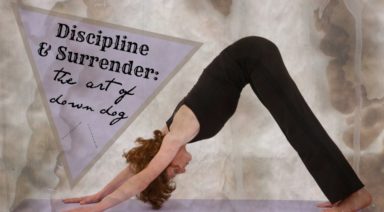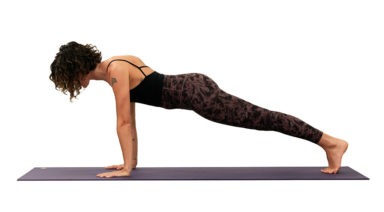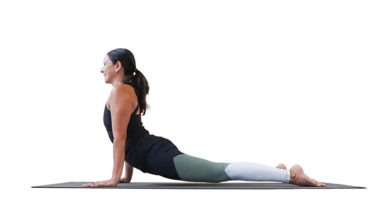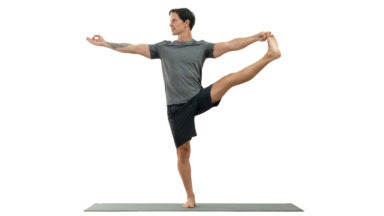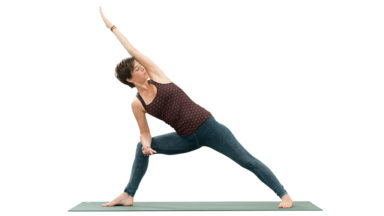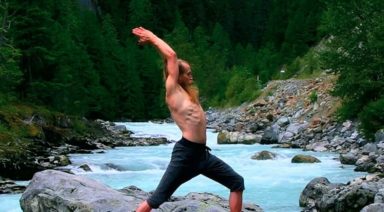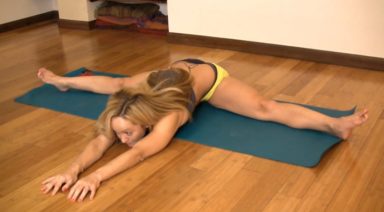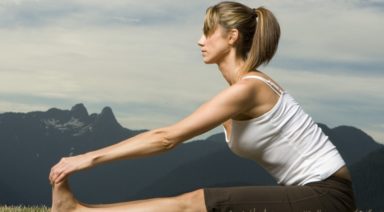5 Detox Yoga Poses
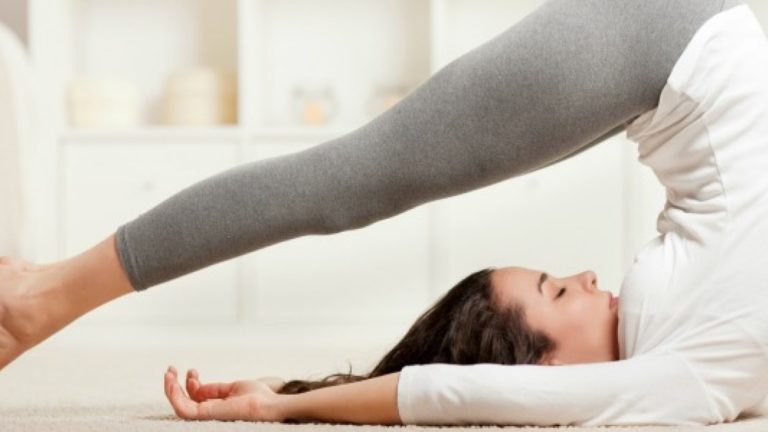
It’s the perfect time to become your healthiest and whole self. You cannot extend to others what you, yourself do not contain. Become your happiest, healthiest, self this year and extend that health and joy to those around you. Don’t only focus on detoxing your physical body, but detox your relationships as well. As we cleanse our physical bodies, it is just as important to surround ourselves with healthy people.
What about your mental clarity? Your spiritual being? Are all these areas cleansed? What steps do you need to take to detox your entire life? Below are five detox yoga poses that can help you detoxify your physical body. We will focus on revolved and inverted yoga asanas as each of these asana families will detoxify your entire system. We will explore three revolved postures and two inversions.
Twists and Revolved Poses
A twist will not only leave you feeling energized and focused but will also give you mental clarity, relieve stress and deep tension and will detoxify your entire system by primarily massaging your internal organs. I like to tell students to think of a dirty washrag being wrung out; This is what we are doing to our systems as we practice revolved postures.
These can be incorporated into almost every yoga posture, whether we’re seated, standing, balancing, prone or in a supine (on your back) position. Revolved postures can be challenging. You will need patience in your journey with twists, as they can be challenging and uncomfortable in the beginning. The more you practice these demanding poses, the better you will become, so embrace where you are and enjoy the journey.
Yoga twists increase the flexibility of your entire abdominal wall including obliques and most back muscles. Inactivity can reduce the range of movement available to all your joints. Twists can assist in mobilizing the joints of your spine by rotating each vertebra gently. Any revolved pose will squeeze the internal organs and encourage the flow of oxygenated blood while eliminating toxins and metabolic waste products. The liver, kidneys, stomach, pancreas, and spleen all benefit from the twisting poses of yoga. Twisting poses can also help reduce abdominal bloating and digestive discomfort.
Revolved Triangle Pose or Parivrtta Trikonasana
Benefits:
- Strengthens and stretches the legs( especially the thighs), knees, ankles and arches
- Stretches and opens the chest, lungs, shoulders, groins and spine
- Increases lung capacity
- Stimulates abdominal organs aiding in digestion and circulation
- Improves alignment of the spine; improving posture and increasing flexibility and mobility of the spine
- Improves balance
- Can be therapeutic for backache, arthritis, infertility, constipation, asthma and sciatica
- Increases stamina and energizes
- Improves concentration, focus, will power and mental clarity
- Relieves, stress, anxiety and depression
Cautions:
If you have a major spinal injury you should avoid this posture. Use caution if you have a headache, high or low blood pressure, an ankle or knee injury, insomnia, or a shoulder injury. If you have a neck injury, keep your gaze either facing forward or towards the ground.
Revolved Chair or Parivrtta Utkatasana
Benefits:
- Rejuvenates the blood system throughout the entire body
- Stimulates and massages the abdominal organs (including ovaries, prostate gland, bladder and kidneys). This improves and relieves digestion issues and tones the abdominal wall
- Strengthens the obliques and transverse abdominal, as well as opens the arm pits and strengthens inner and outer intercostal muscles
- Strengthens and stretches the back muscles, aligns and awakens the spine and improves posture
- Stretches and strengthens the calves, quadriceps, hamstrings, hips, shoulders, chest, feet, ankles, knees and spine; relieves tension in the back, neck and shoulders
- Increases flexibility, lubricates ankle and knee joints and awakens the legs
- Stimulates the heart, improves circulation, respiratory and lymphatic systems
- Therapeutic for mild sciatica, backache, arthritis, osteoporosis, flatulence, menopause, menstrual discomfort and can improve infertility issues
- Reduces stress and anxiety
- Stimulates and energizes the nervous system
- Improves concentration, stamina, mental focus and relieves mild depression
- Relieves mental and physical lethargy and exhaustion
- Calming, centering and balancing; it brings a state of tranquility as well as can be invigorating
Cautions:
Use caution if you have high or low blood pressure; a headache or migraine; low back or shoulder injury; insomnia; a hip, knee or ankle injury, severe asthma, sciatica, degenerated or herniated disk(s); or are pregnant
Half Twist Pose or Ardha Matsyendrasana
Benefits:
- Stimulates and massages the abdominal organs (ovaries, prostate gland, bladder and kidneys), improving and relieving digestion issues, as well as toning the abdominal wall
- Strengthens the obliques and transverse abdominal
- Strengthens inner and outer thighs
- Strengthens and stretches the back muscles, aligns and awakens the spine, improves posture
- Stretches the hips, shoulders, chest and spine, relieving tension in the back, neck and shoulders
- Increases flexibility and lubricates ankle and knee joints, awakening the legs
- Stimulates heart and improves circulation
- Therapeutic for mild sciatica, backache, arthritis, osteoporosis, flatulence, menopause, menstrual discomfort and can improve infertility issues
- Reduces stress and anxiety
- Stimulates and energizes the nervous system
- Improves concentration, mental focus and relieves mild depression
- Relieves mental and physical lethargy and exhaustion
- Calming, centering and balancing. Brings a state of tranquility and can be invigorating
Cautions:
Use caution if you have a low back or shoulder injury; hip, knee or ankle injury; severe sciatica, degenerated or herniated disk; a headache or migraine; or are pregnant.
Inverted Yoga Postures
Inversions are postures that typically have the heart and often the feet, higher than the head. Most inversions stimulate your pituitary gland, promoting a positive state of well-being and rejuvenation. Inversions also benefit the cardiovascular, lymphatic, endocrine and nervous systems while stimulating the lymphatic system which strengthens the immune system and also improves digestion.
Cardiovascular benefits of inversion postures provide more efficient circulation caused by a fresh delivery of blood to the heart. Being inverted also increases blood flow to your head, relieving the heart of some of its duties and can lower blood pressure and heart rate. Your endocrine system is responsible for hormone delivery. Inversions, especially shoulder stands, are recommended for perimenopausal and menopausal women due to the belief that the postures will stimulate the thyroid and parathyroid glands, regulating your metabolism. The benefits to the nervous system during inverted postures include the stimulation of cerebrospinal fluid or CSF, which is the fluid of the central nervous system that flows from the brain to the spinal cord.
Plow Pose or Halasana
Benefits:
- Stimulates abdominal organs, ovaries, prostate gland, bladder and kidneys. This improves and relieves digestion issue and tones the abdominal wall
- Stimulates the thyroid and parathyroid glands which increases metabolism and stimulates the nervous, digestion and respiratory systems
- Strengthens and stretches the back muscles, aligning spine and improving posture
- Opens the shoulders and chest and relieves tension in the back, neck and shoulders
- Awakens the legs
- Stimulates the heart and improves circulation
- Therapeutic for headaches, migraines, backache, menopause discomfort, infertility, insomnia and sinusitis
- Reduces stress and anxiety
- Improves concentration, mental focus and relieves mild depression
- Relieves mental and physical lethargy and exhaustion
- Calming and centering, it brings a state of tranquility and over all well-being
- Invigorating and rejuvenating
Cautions:
If you have asthma or high/low blood pressure, practice with feet on raised props. Use caution if you have severe sciatica or a herniated disk; if you have a back, neck or shoulder injury, if you’re menstruating, if you have glaucoma.
If you’re pregnant but experienced in this posture, you may continue to practice until the third trimester. If you’re inexperienced with plow after becoming pregnant, you should avoid this posture
Tripod Headstand Pose or Salamba Sirsasana
Benefits:
- Stimulates abdominal organs, ovaries, prostate gland, bladder and kidneys. This improves and relieves digestive issues and tones the abdominal wall
- Strengthens the entire musculoskeletal system
- Stimulates the thyroid and parathyroid glands which increases metabolism and stimulates the nervous, digestion and respiratory systems
- Strengthens and stretches the back muscles by aligning the spine and improving posture
- Opens the shoulders and chest and relieves tension in the back, neck and shoulders
- Awakens, stretches and strengthens the entire body and spine
- Stimulates heart and improves circulation
- Therapeutic for headaches, migraines, backache, menopause, menstrual discomfort, infertility, insomnia and sinusitis
- Reduces varicose veins
- Reduces stress and anxiety
- Improves balance and concentration, mental focus and relieves mild depression
- Relieves mental and physical lethargy and exhaustion
- Calming and centering, it brings a state of tranquility and overall well-being
- Invigorating and rejuvenating
Cautions:
Use caution if you have high or low blood pressure; a headache or migraine; a back, neck or shoulder injury, severe sciatica or a herniated disk; and if you’re menstruating; pregnant; have diarrhea; have glaucoma.
Partner Yoga Poses: The Power of Connectivity
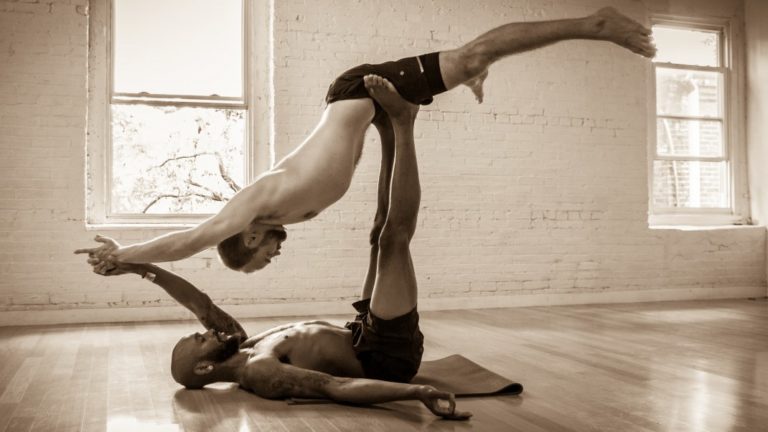
Want to heighten your yoga experience? Deepen your practice through body and mind with partner yoga: Partner Yoga Level One and Partner Yoga Level Two, led by instructor Pedro Franco, are perfect for yoga lovers. Partner yoga is a practice for any level of yogi. It can be done with a friend, loved one or acquaintance. Through this fun and connected series, you will learn to strengthen and amplify your practice by creating a greater sense of awareness in your own body while also paying close attention to the presence and movements of your partner. Partner yoga poses are great if you want to try something new or to spice things up in your relationship with more intimate couples yoga poses.
Things to Keep in Mind When You Start Your Partner Practice
- Partner yoga does not have to be complicated to be beneficial
- Partner yoga can simply be sitting back-to-back with your partner and breathing. It can be meditative. It can be as simple as massaging your partner’s sacrum after a stretch or wiggling your partner’s legs after a flying pose
- Partner yoga works on the same principles as individual yoga: Listen to your body and do what feels right. Challenge yourself, but only to a healthy limit
- If you’re new to partner yoga, take time to build strength, stability and flexibility in order to grow in the practice. Remember that in any form of yoga, there is no competition. For as many times as you stumble, you have just as many opportunities to try again. It is the act of connecting that matters most, not reaching a pose
Start with a Simple Partner Yoga Pose
Partner yoga can be a challenge for even the most advanced practitioner: It doesn’t matter how many hours you have spent on your mat, how many downward dogs or side crows you have done in your life. Maybe you are focused and resilient but need to work on your strength. Maybe you are strong and advanced in your movements but need to work on the act of giving yourself to your partner in a selfless manner.
Partner Seated Spinal Twist (Janu Sirsasana)
-
Begin by sitting back-to back in a comfortable cross-legged seated position
-
Each partner places their right hand on the other’s partner’s left thigh just above knee
-
Put your left hand on your own right knee
-
Coordinate your breathing by lengthening through spine on each inhale
-
During each exhale, twist a little more
-
Come back to center seated and repeat on other side
Learn the Art of Balancing with Your Partner
Partner yoga is not just about you. It is about the other person, too. Partner yoga poses exist to teach yogis and anyone interested in the practice how to gain better awareness and alignment of the body through precise adjustments and articulated movements.
Partner Boat Pose (Navasana)

-
Start by having each partner sit at the end of the mat facing each other
-
Each partner will bend their knees and press the soles of their feet together
-
Connect by clasping each other’s hands
-
While keeping the soles of your feet together, lean back slowly
-
Lengthen your legs and reach your feet upward to a bent-legged boat pose
-
Continue to breathe while you work on your balance
Create Greater Intimacy with Your Partner
Partner yoga can be as intimate as you allow it to be. Partner yoga is for anyone and everyone. It is about trust. It is about connection. It is about feeling the electric sensation between you and another person. It has the power to strengthen bonds between friends, unite strangers and fuse couples together in a new and stimulating way. Partner yoga has the powerful ability to create a profound level of intimacy between two people. The combination of breath, balance, trust and connection create for a unity that is unlike any other. It is assumed by many that partner yoga is purely sexual. This is not true. Yes, partner yoga can be a sensual experience if you want it to be, especially in couples yoga poses. It can also be an experience of unity in a completely different way. It can be whatever you want it to be. That is the beauty of the practice.
Partner Dancer’s Pose (Nataranjasana)

-
Start by standing up toward the back edge of your mat, facing your partner
-
Grab your partner’s right hand
-
Each partner will slightly bend the knees
-
Shift your weight onto your right leg
-
Bend the left knee and gran onto the inside of the left ankle or calf with your left hand
-
Gently pressing your shin into your left hand, open your back
-
Finally, reach your right arm up to balance
-
Repeat on the other side
Connect with Your Partner
Partner yoga is not just about you. Partner yoga has the word partner in it for a reason. It is a practice for two and is a practice that focuses on the unity of two. This is the idea that we should be incorporating in our partner yoga practice. Listen to your partner’s needs. Are they comfortable? Do they feel supported? Do they feel capable of holding you in a pose? Are they calm and present? Through the power of breath and touch, you will be able to sense your partner’s physical and emotional state. Yes, you need a partner to fly. You need a partner to pull your legs and lift you up. But your partner also needs you. It all comes back to unity. In these partner yoga poses and couples yoga poses, we rely on each other and so we must move in a way that represents that.
Double Standing Forward Bend (Uttanasana)
-
Stand back-to-back with your partner
-
Leave about 6 to 12 inches between you and your partner’s heels
-
Each partner will bend at the waist and come to a forward fold
-
Reach your hands behind you
-
Grab onto your partner’s hands
-
As you increase flexibility, you may be able to grab your partner’s forearms, elbows or even shoulders
-
Walk your heels closer until your bottoms are touching and straighten your legs
-
Lengthen the spine, head dangling toward the ground
Explore AcroYoga
AcroYoga is the combination of yoga, massage and acrobatics. As with partner yoga, which often includes acrobatic poses, shown in the Partner Yoga Level Two video, it is important to focus on the building blocks of your practice. Start with what you know and allow yourself to grow through continual practice, one step at a time. Motivation and repetition are the keys to helping you excel at AcroYoga. A common misconception about AcroYoga is that the size of your partner matters. This is not always true. Believe it or not, you have the ability to lift someone twice your weight. It is all about your technique.
As an extension of partner yoga, AcroYoga relies on the same principles: trust, communication and connection. Once you master these skills, you will be flying in the air and lifting people up with your feet in no time. Here is a fun beginner’s partner AcroYoga pose to test out your skills.
Flying Plank (A)
-
Base lies on back
-
Base places legs up in the air, heels over hips
-
Flyer starts by standing facing the base, with their toes almost touching the base’s glutes
-
Base bents knees slightly to bring feet to the hipbones of the flyer
-
Base and flyer connect hands, palm to palm and fingers interlaced
-
Flyer leans forward into the base’s feet
-
With flyer’s body in a single line, the base will receive the weight of the flyer in their feet
-
Base will then straighten their legs and stack their heels directly over the flyer’s hips
-
The flyer should have an engaged core, and the base should have straight arms and shoulder blades firmly grounded into the mat for maximum support and balance
From Flying Plank, yogis can work into the variation below: the flyer leans into the base’s hands instead of feet.

Flying plank photo credit: Amy Goalen
Just as we protect our family, friends and loved ones, we must protect each other when practicing partner yoga. Emotionally and physically, we must rely on each other to reach the ultimate goal of unity and connection.
Thank you to Amy Goalen for providing the beautiful main article image!




